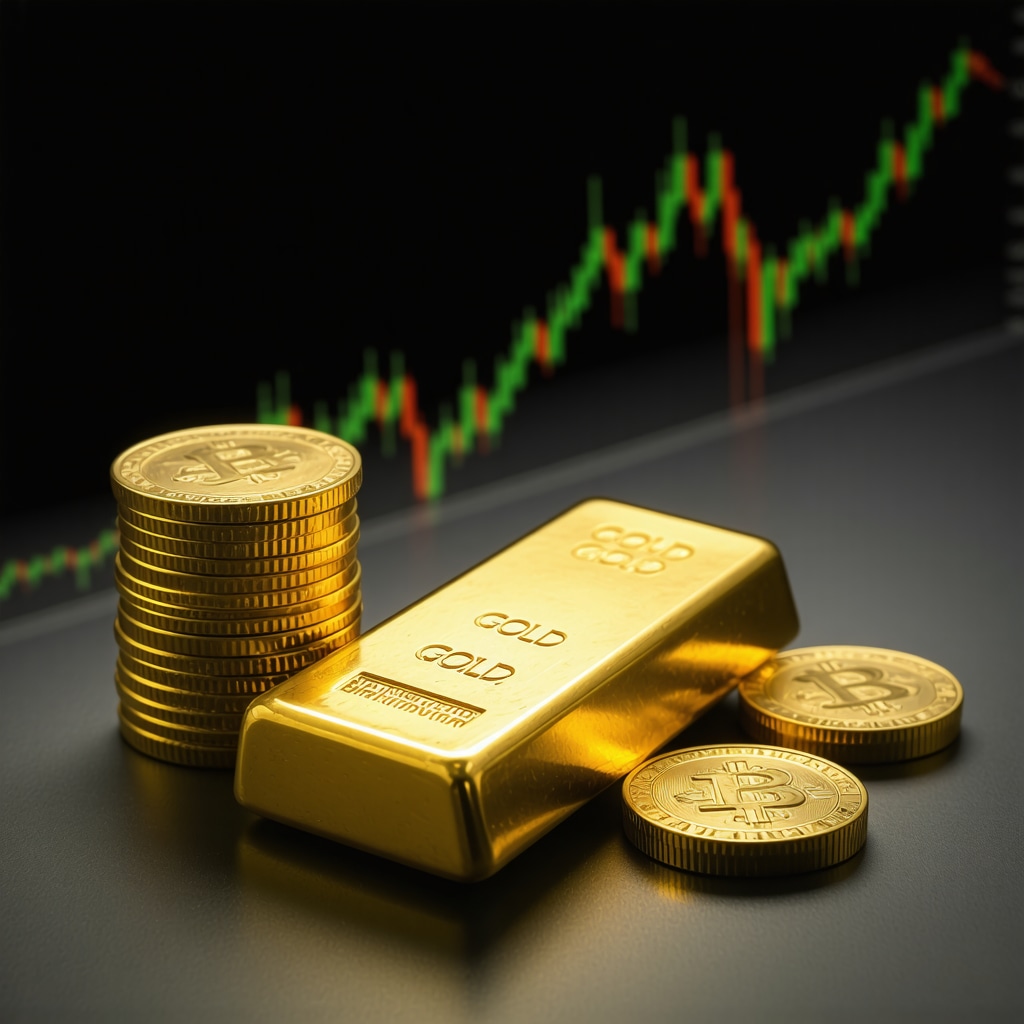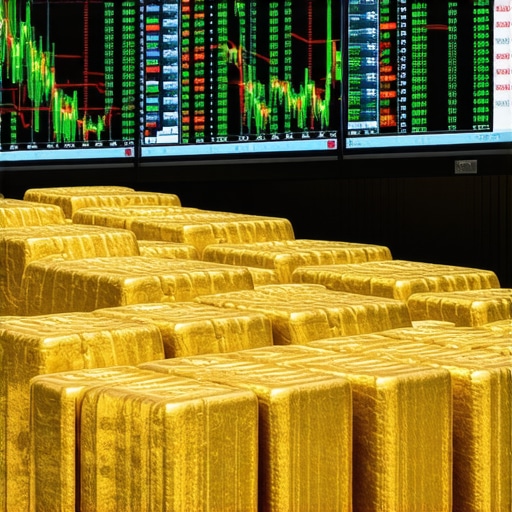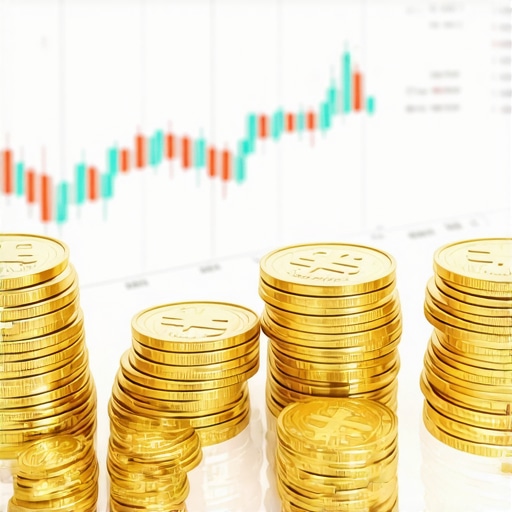Unveiling the Timeless Shield: Gold’s Role Amid Stock Market Turbulence
In an era marked by unprecedented economic uncertainty and market volatility, discerning investors continually seek assets that provide stability and preserve wealth. Among these, gold stands out as the quintessential hedge against stock market fluctuations. Unlike equities, which are susceptible to corporate performance and macroeconomic cycles, gold has a unique capacity to retain intrinsic value, acting as a safe haven when confidence in financial markets wanes.
Decoding the Divergence: Why Gold and Stocks Often Move Oppositely
Historically, gold and stock markets exhibit an inverse correlation, a dynamic that stems from their fundamentally different value drivers. Stocks represent ownership in companies, influenced by earnings growth, interest rates, and economic outlooks. Conversely, gold is valued for its scarcity, tangible nature, and role as a store of value during inflationary periods or geopolitical distress. During market downturns, when investors fear equity losses, gold’s allure intensifies, driving prices upward as a refuge.
How Does Gold Maintain Its Value When Equities Falter?
Gold’s enduring value is anchored in its physical properties and limited supply. Unlike fiat currencies prone to inflationary erosion, gold is a finite resource whose supply increases only marginally each year through mining. Additionally, it is universally recognized and accepted, making it a liquid asset globally. For example, during the 2008 financial crisis, while the S&P 500 plummeted by over 37%, gold prices surged approximately 25%, illustrating gold’s protective buffer against equity losses.
Leveraging Gold: Strategic Allocation for Portfolio Resilience
Investment experts often recommend allocating a portion of portfolios to gold to reduce overall risk and enhance diversification. Gold’s low or negative correlation with stocks can smooth portfolio volatility and protect purchasing power over time. Instruments like physical bullion, gold ETFs, and gold mining stocks offer varied exposure tailored to investor preferences. For newcomers, resources such as investing in gold for beginners provide invaluable guidance to navigate this asset class effectively.
Gold in the Modern Era: Inflation Hedge and Crisis Currency
With inflationary pressures intensifying globally, gold’s role as a hedge against currency debasement gains renewed relevance. Unlike stocks, which may suffer earnings compression under rising input costs, gold typically appreciates as real interest rates decline. Moreover, geopolitical tensions and systemic financial risks amplify demand for gold, reinforcing its status as the ultimate hedge. Analysts from the World Gold Council emphasize this dual function, underscoring gold’s unique position within diversified portfolios (World Gold Council Report).
Practical Wisdom: How to Integrate Gold Without Overexposing Your Portfolio
While gold offers compelling protection, it is essential to balance its allocation prudently to avoid opportunity costs. Investors should consider personal risk tolerance, investment horizon, and market conditions. Diversification within gold investments—balancing physical gold, ETFs, and mining equities—can optimize returns and liquidity. For a deeper dive into strategic gold investing, explore top gold investment strategies that safeguard wealth in volatile economic times.
Join the Conversation
Have you found gold to be a reliable hedge in your investment experience? Share your insights or questions in the comments below, and explore more expert gold investment strategies to fortify your financial future.
Finding Balance: My Journey in Allocating Gold Within a Diverse Portfolio
Reflecting on my personal investment journey, one of the most pivotal lessons has been the art of balancing gold with other asset classes. Early on, I was tempted to load up heavily on gold, enamored by its reputation as a safe haven. However, after experiencing both the ups and downs of the market, I realized that overexposure can limit growth opportunities. Allocating around 10-15% of my portfolio to gold has provided a cushion during turbulent times, without sacrificing the potential gains from equities and bonds.
In practice, this meant purchasing a mix of physical gold coins and shares in gold ETFs. The physical gold offers tangible security and peace of mind, especially in uncertain geopolitical climates, while ETFs bring liquidity and ease of trading. This balanced approach helped me navigate market swings more confidently, underscoring that gold’s role is to complement, not dominate, an investment portfolio.
Understanding the Nuances of Gold Investment Vehicles
Delving deeper, I’ve come to appreciate the differences between various gold investment options. Physical gold, such as bullion and coins, brings the advantage of ownership and no counterparty risk, but it requires secure storage and sometimes entails higher transaction costs. Gold ETFs, on the other hand, provide convenient exposure and can be bought or sold quickly, but they carry management fees and depend on the financial system’s integrity.
Moreover, gold mining stocks introduce an entirely different dynamic. Their prices don’t just track gold prices; they’re also influenced by company performance, operational costs, and broader stock market trends. While mining stocks can offer leveraged returns during gold price rallies, they also carry additional risks. I found that a modest allocation here—often through diversified mutual funds or ETFs focused on gold miners—can enhance portfolio returns without excessive volatility.
How Do You Choose the Right Gold Investment for Your Goals?
This question kept me pondering for quite some time. The answer, I discovered, rests on several factors: your risk tolerance, investment timeline, liquidity needs, and belief in the underlying gold market fundamentals. For example, if you’re seeking immediate liquidity and ease of management, gold ETFs or mutual funds might be preferable. Those valuing physical possession and long-term security may gravitate towards bullion or coins. And if you’re comfortable with stock market exposure and want growth potential, the mining sector presents opportunities.
For readers interested in exploring these options further, I recommend checking out comprehensive guides like types of gold investments explained which provide a detailed breakdown of pros and cons tailored to different investor profiles.
Gold’s Psychological Edge: Why It Feels Like a Safety Net
Beyond numbers and charts, I noticed that gold carries a psychological comfort that few other assets can match. Holding something tangible, something that has preserved value through centuries, offers reassurance in uncertain times. This emotional aspect often influences investment decisions as much as financial logic. A study I came across from the World Gold Council highlights that during periods of market stress, investor demand for physical gold spikes significantly, reflecting this psychological behavior (World Gold Council Report).
This insight resonated with me deeply. It reinforced the idea that gold isn’t just a commodity or an investment vehicle—it’s a form of financial insurance that provides peace of mind when traditional markets falter. Recognizing this helped me appreciate gold not simply for its price movements but for its role in holistic wealth preservation.
Practical Steps: Safeguarding Your Gold Investments
One challenge I faced was ensuring the security and authenticity of my gold holdings. Buying from trusted dealers, verifying certifications, and understanding storage options became essential. For physical gold, I opted for a mix of home safe storage for smaller amounts and professional vault services for larger quantities, balancing accessibility and security.
For those new to this, exploring tips on best practices for buying gold coins and bars can be invaluable. These guidelines help avoid pitfalls like counterfeit products or overpaying premiums. Similarly, understanding how to safely store gold ensures your investment remains protected against theft or damage.
What’s Your Experience With Gold? Let’s Chat!
Have you included gold in your portfolio? How do you balance its various forms, and what lessons have you learned along the way? I’d love to hear your stories or questions—feel free to share them in the comments below. And if you want to dive deeper, check out more resources on gold demand trends and strategies to optimize your investment approach.
Harnessing Advanced Gold Instruments: Derivatives, Futures, and Options Demystified
For seasoned investors aiming to elevate their gold exposure beyond traditional holdings, the realm of derivatives offers sophisticated avenues that can amplify returns or hedge risk. Gold futures contracts, traded on exchanges such as COMEX, enable investors to agree today on buying or selling gold at a specified price on a future date. This mechanism provides leverage but demands a nuanced understanding of margin requirements and market volatility.
Similarly, gold options grant the right, but not the obligation, to buy (call) or sell (put) gold at predetermined strike prices within a set timeframe. These instruments can be employed to protect portfolios against adverse price movements or to speculate on anticipated trends with defined risk limits. However, they require a firm grasp of option Greeks and time decay effects.
Integrating these derivatives into a portfolio necessitates robust risk management frameworks and continuous market monitoring. The CME Group provides comprehensive resources and contract specifications essential for investors seeking to navigate this complex landscape.
Unpacking the Psychological Resilience: Behavioral Finance Insights Into Gold’s Enduring Appeal
Beyond the tangible attributes of gold lies a profound psychological impetus driving investor behavior. The cognitive biases associated with loss aversion and uncertainty often elevate gold’s appeal during market turmoil. Investors tend to overweight the security offered by physical gold, even at the expense of potential gains, due to its status as a symbol of stability and wealth preservation across cultures and history.
Academic studies in behavioral finance illustrate how this “safe haven” perception is reinforced by social proof and herd mentality, particularly when traditional financial instruments falter. This collective sentiment can create self-fulfilling price dynamics, where escalating demand bolsters gold prices beyond fundamental valuations. Recognizing these psychological undercurrents equips investors to distinguish between rational hedging and emotionally driven market exuberance.
How Can Sophisticated Investors Leverage Behavioral Patterns Without Falling Prey to Bias?
Astute investors integrate behavioral insights by setting clear investment rules and leveraging algorithmic trading models that minimize emotional interference. Tools that track sentiment indicators and gold demand metrics—such as central bank reserves and ETF inflows—offer data-driven signals to complement qualitative judgment.
For instance, understanding that spikes in physical gold purchases often precede price surges allows for calibrated entry points, while monitoring contrarian signals can prevent chasing overheated markets. Resources like the World Gold Council’s Behavioral Finance Research provide valuable frameworks for integrating psychology into investment strategy.
Structural Shifts in Global Gold Demand: Emerging Market Dynamics and Central Bank Policies
Emerging economies, particularly in Asia, continue to reshape gold demand through cultural affinity and growing wealth. Countries like India and China are pivotal, with household jewelry and investment demand often counter-cyclical to Western market trends. Moreover, central banks globally have become net buyers of gold, diversifying reserves away from traditional currencies amid geopolitical uncertainties.
This trend influences global liquidity and price discovery mechanisms, necessitating investors to monitor geopolitical developments and monetary policies closely. The strategic accumulation of gold reserves by sovereign entities can cause long-term price support, while shifts in trade policies or import tariffs can introduce volatility.
Keeping abreast of these macroeconomic and policy-driven factors is essential for tailoring gold exposure to evolving global contexts.
Join the Expert Dialogue
Are you utilizing advanced gold instruments or behavioral insights in your investment approach? Share your strategies or questions below to engage with a community of experts and refine your portfolio resilience. For continued learning, explore our detailed analyses on advanced gold investment techniques that delve deeper into market mechanics and psychological factors.
Decoding Gold’s Strategic Role in Complex Portfolio Architectures
As global financial markets evolve with increasing complexity, integrating gold within multifaceted portfolio frameworks demands a nuanced understanding of its interrelation with alternative asset classes. Beyond the conventional role of a safe haven, gold’s correlation dynamics with cryptocurrencies, real estate, and sovereign bonds can shift based on macroeconomic regimes, monetary policy shifts, and geopolitical shocks. For example, during periods of stagflation, gold’s positive correlation with inflation-indexed bonds enhances its utility as an inflation anchor, whereas in deflationary environments, its performance may diverge significantly.
Seasoned portfolio managers leverage advanced quantitative tools such as regime-switching models and copula functions to dynamically adjust gold exposure, optimizing risk-adjusted returns while safeguarding against tail risks. These sophisticated methodologies highlight gold’s capacity as both a strategic diversifier and a tactical instrument in volatility mitigation.
Harnessing Gold-Backed Digital Assets: Navigating the Intersection of Tradition and Innovation
The emergence of gold-backed digital tokens and blockchain-based gold ETFs introduces a transformative paradigm in gold investment, marrying the asset’s traditional stability with the liquidity and accessibility of decentralized finance. These instruments facilitate fractional ownership, instantaneous settlement, and enhanced transparency, appealing to tech-savvy investors seeking seamless integration of precious metals into digital portfolios.
However, this innovation entails distinct challenges, including smart contract vulnerabilities, custodial counterparty risks, and regulatory uncertainties. Meticulous due diligence, including evaluating the token’s underlying gold verification protocols and the issuer’s regulatory compliance, is imperative for safeguarding investments in this nascent domain.
How Can Investors Effectively Evaluate the Credibility and Security of Gold-Backed Digital Tokens?
Evaluating these digital assets requires a multi-dimensional approach encompassing technological, legal, and operational facets. Investors should scrutinize the audit frequency and transparency of the gold reserves, the security architecture of the blockchain platform, and the governance framework overseeing token issuance. Engaging with third-party assurance reports and regulatory filings enhances confidence in the token’s integrity.
Moreover, understanding the liquidity profile and secondary market dynamics aids in assessing exit strategies and price stability. Resources like the Investing News Network’s guide on digital gold tokens provide comprehensive evaluations tailored for discerning investors.
Macroprudential Impacts: Central Bank Gold Policies in a Post-Pandemic World
The post-pandemic economic recovery phase has witnessed central banks recalibrating their gold reserve policies amidst unprecedented fiscal stimuli and currency debasement concerns. The strategic accumulation or liquidation of gold reserves by monetary authorities significantly influences global gold liquidity and price discovery mechanisms.
Central banks in emerging markets, particularly in Asia and the Middle East, have accelerated gold purchases to diversify away from dominant reserve currencies, thereby reinforcing gold’s geopolitical and financial significance. Concurrently, shifts in international trade dynamics and cross-border capital flows necessitate vigilant monitoring to anticipate their reverberations on gold markets.
Incorporating these macroprudential insights into investment decision-making can provide advanced investors with a strategic edge.
Join the Advanced Investor Forum
Are you integrating gold-backed digital assets or macroprudential central bank trends into your investment thesis? Share your advanced strategies and queries in the comments below to connect with a community of experts driving innovative gold investment approaches. Dive deeper into these sophisticated themes by exploring our curated analyses on advanced gold investment techniques.
Frequently Asked Questions (FAQ)
Why does gold often move inversely to the stock market?
Gold and stocks have fundamentally different value drivers. Stocks depend on corporate earnings and economic growth, while gold is prized for scarcity and as a store of value during inflation or crises. In downturns, investors seek gold’s stability, driving prices up as equities fall.
What percentage of my portfolio should be allocated to gold for optimal diversification?
Experts typically recommend allocating between 5% and 15% to gold, balancing protection against market volatility without sacrificing growth opportunities. The exact percentage depends on individual risk tolerance, investment horizon, and market conditions.
How do gold ETFs compare to physical gold investments?
Gold ETFs offer liquidity, ease of trading, and lower transaction costs but carry counterparty and management fee risks. Physical gold provides tangible ownership and no counterparty risk but requires secure storage and may involve higher premiums and less liquidity.
Can gold mining stocks be considered a direct substitute for holding gold?
Not exactly. Mining stocks are influenced by gold prices but also company performance, operational risks, and market sentiment. They can provide leveraged exposure but carry additional volatility compared to physical gold or ETFs.
Are gold-backed digital tokens a safe alternative for gold investment?
Gold-backed digital tokens combine traditional gold stability with blockchain liquidity and transparency. However, they bring risks such as smart contract vulnerabilities, custodial counterparty risk, and regulatory uncertainty. Thorough due diligence is essential.
How do central bank gold purchases affect gold prices?
Central banks’ strategic accumulation or liquidation of gold reserves impact global supply and demand dynamics, influencing liquidity and long-term price trends. Emerging market central bank buying often supports gold prices amid geopolitical and currency concerns.
What behavioral finance factors influence gold investment decisions?
Investor psychology, including loss aversion and herd behavior, elevates gold’s appeal during uncertainty. These biases can drive demand spikes and price volatility beyond fundamental values, necessitating disciplined, data-driven investment approaches.
How can I safely store physical gold?
Options include secure home safes for small quantities and professional vault services for larger holdings. Verification of authenticity and purchasing from reputable dealers are critical to avoid counterfeit risks.
What are the main risks associated with investing in gold futures and options?
These derivatives provide leverage but require understanding margin calls, price volatility, and option Greeks. Risks include potential significant losses and complexity unsuitable for inexperienced investors.
How does gold perform during inflationary versus deflationary environments?
Gold generally acts as an inflation hedge, appreciating as real interest rates fall. In deflationary periods, its performance can be mixed, sometimes diverging from inflation-indexed bonds and equities, highlighting the importance of macroeconomic context.
Trusted External Sources
- World Gold Council (gold.org): Authoritative research on gold demand trends, investor behavior, and strategic portfolio integration, providing data-driven insights and market analysis.
- CME Group (cmegroup.com): Detailed information on gold derivatives including futures and options contracts, essential for understanding market mechanics and risk management.
- Investing News Network (investingnews.com): Comprehensive guides on digital gold tokens and emerging gold investment technologies, useful for evaluating innovative asset classes.
- International Monetary Fund (imf.org): Reports and data on central bank gold reserves and macroeconomic impacts, critical for understanding global monetary policy influences.
- Journal of Behavioral Finance: Academic studies illuminating psychological factors affecting gold investment decisions, enriching the understanding of market sentiment and cognitive biases.
Conclusion
Gold remains a cornerstone for investors seeking stability amid stock market volatility and economic uncertainties. Its unique role as a tangible asset, inflation hedge, and psychological safe haven complements diversified portfolios, mitigating risk and preserving wealth. Whether through physical bullion, ETFs, mining equities, derivatives, or emerging digital tokens, understanding the nuances of each investment vehicle is crucial for effective allocation. Incorporating behavioral finance insights and monitoring macroprudential trends, especially central bank policies, empowers sophisticated investors to optimize gold’s strategic potential. As financial landscapes evolve, gold’s timeless value endures, inviting investors to harness its protective qualities thoughtfully. Share your experiences, explore further expert analyses, and apply these insights to fortify your portfolio resilience in an ever-changing market environment.










